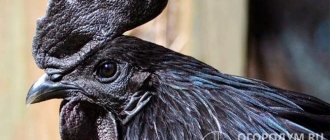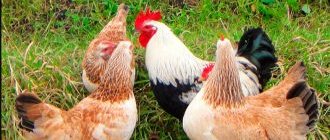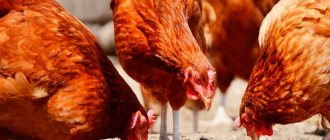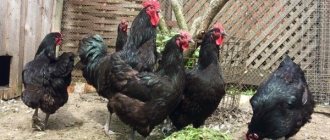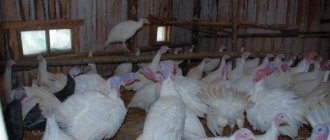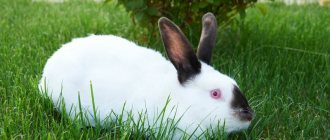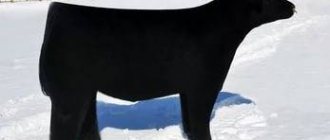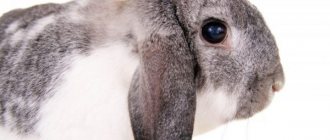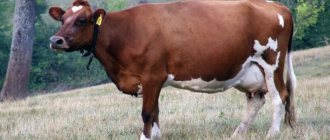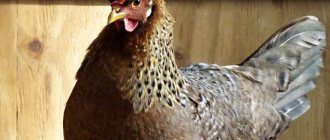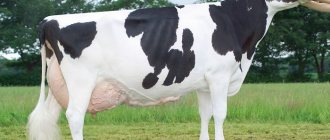The Maran is a breed of chicken famous for laying eggs with chocolate-colored shells. They look as if they were painted with a strong decoction of onion skins, which is why they are called Easter. Poultry belongs to the meat and egg direction. It is not very common in Russia, but many farmers are interested in the unusual poultry. Before you buy Maran chickens, you should learn more about the characteristics of the breed, its advantages and disadvantages.
Maran chicken breed
How did the breed appear?
The Maran breed was developed by breeders from France in 1895. But the unique qualities of the animals could only be assessed after 29 years. In 1914, the creators decided to present their new breed at the La Rochelle exhibition. Since then, the birds have become popular all over the world.
Many poultry farmers still prefer this breed. The bird was bred in the city of Marans, located in western France. This has contributed to the fact that animals adapt well to adverse weather conditions.
History of Maran chickens
In the 19th century, when the Indian breeds of Brahma and Lanshan chickens came into fashion, French Marans were crossed with these chickens. The French Maran is a breed of chicken with feathered legs. The first birds were presented at the exhibition in 1914. In 1929, the Maran Breeding Club was organized in France. The standard was adopted in 1931, where the Maran is a breed of chicken, the description of which clearly states that the bird's metatarsus must be feathered. In 1934, marans were shown at an exhibition in England. It is not known why the English breeders were not satisfied with the small number of feathers on the metatarsus of chickens, but for breeding they selected only marans with “clean” legs.
“Bare-footed” marans were bred in England in sufficient numbers, but France did not recognize this line in the breed. In 1950, Great Britain established its own Marans Club. And from that moment on, another “hundred years war” began between France and England.
French chickens of the Maran breed in the photo (with feathering on the metatarsus).
Already at the beginning of the 21st century, three English clubs for breeding Marans were created and disbanded again. America's breeders kept pace with the Old World, and the original Association fell apart as a result of differing views on the standard of the Maran chicken. On its ruins, a new Marano Club of America was created, recognizing the French breed standard. The French standard is recognized by most countries. The only question is whether to “legalize” both versions of marans or only one of them in the national standard.
Interesting! Initially, marans had only a cuckoo color.
Motley is still the most common color among Maranas today, but in Russia the black-and-copper Marana chickens are better known.
Description of the Marans
Externally, Maranas look very attractive. Throughout the year, the birds' plumage remains just as bright. These are animals with a powerful body, but they do not seem “heavy” and clumsy; on the contrary, they look noble and majestic.
The body size is medium, the build is good, the plumage is dense. Birds have a long body, wide and high shoulders. On the strong and long neck there are many long feathers that form a kind of collar. A powerful chest, a developed belly, wings pressed tightly to the body - these characteristics indicate that the bird is strong. The legs are shortish, white or slightly pinkish in color. But birds with dark plumage may have gray or dark gray legs.
The Moran's head is small, slightly elongated. On the head there is a middle ridge with sharp ends. Earrings and earlobes are red. Distinctive features are orange-red eyes and a strong, curved yellow beak.
The birds are active and mobile, at the same time calm and non-aggressive. This is convenient for poultry farmers breeding several breeds at once.
Distinctive features
Appearance
Marans are a breed of chickens, the description of which implies several breed characteristics by which these birds are easy to recognize:
- powerful and elongated body;
- chest muscles are well developed;
- the back is elongated and flat;
- the wide loin is slightly raised and decorated with thick feathers;
- the abdomen is full, slightly drooping;
- small, relative to the size of the body, head;
- the neck curved closer to the head is decorated with long, densely growing feathers covering the shoulders;
- a six-pronged, red leaf-shaped comb (it slopes to the side, but, according to the standard, cannot reach the back of the head);
- red or red-orange eyes;
- the rooster has noticeable large earrings;
- the wings are small and tightly pressed to the body;
- small fluffy tail;
- paws with clearly separated four toes;
- the legs of black chickens are light gray, and those of light ones are white;
- The sole is strictly white.
The breed standard prohibits the Maran's tail from tilting more than 45 degrees.
Difference in standards of different countries
Different countries have different approaches to the standards of Maran chickens.
For example, France and the States recognize only feathered metatarsus in marans. In the UK, only bare legs are allowed. And Australia is happy with both options.
All types of Maran chickens boast close-fitting plumage in a variety of bright colors inherited from fighting ancestors. Birds look especially impressive in sunlight, when the feathers shimmer and sparkle.
Varieties of colors
Originally, Marans had cuckoo-colored feathers. Selection work to breed chickens of other colors did not immediately yield the desired results, since, while achieving a certain color, poultry farmers observed the loss of important breed characteristics. For example, the size of chickens may have decreased or the color of their eggs may have faded.
But gradually it was possible to develop many variations in the colors of the Maran feathers without losing other breed qualities. Today, each color variety has its own breed standard.
Black-copper
A common color. The black-and-copper maran is distinguished by the fact that its body and tail are painted black with an emerald green tint.
The head, lower back and mane of roosters and chickens are painted in a copper shade. The color saturation may vary, but its presence is required.
Golden or silver cuckoo
Golden cuckoo - the golden cuckoo pattern is more clearly visible in chickens.
Silver cuckoo - the rooster is brighter and more saturated in white-silver color.
Wheat
The head, lumbar region and mane of the rooster are colored yellowish-red or brownish-red. The cover feathers are long and practically without a border. At the same time, the lower back and back area are of a darker shade, and the tops of the wings and shoulders are pronounced red. The throat and breast are black, the tail is black and emerald.
Chicken feathers have a pronounced border. They are lighter than those of a rooster. The head, back and neck are gold and red, the lower body is wheat or cream. The dark tail has feathers with red or black edges.
Black silver
The black silver color of the Marans is reminiscent of the copper-black coloring. Only instead of copper there is a silver color of the pen.
White and Colombian
White roosters and hens look especially beautiful. The snow-white feather has no inclusions.
Colombian Maranos are also white, but have a black necklace on their necks.
Lavender (black with blue)
The lavender color in hens appears due to the presence of a gene that helps lighten the black and red pigment of the copper-black maran. The Blue Maran is capable of producing either black chicks or red chicks.
Black-tailed
The black tail feathers of the rooster have an emerald sheen, and the body is painted red. Black-tailed chickens have a tail with a brown feather instead of an emerald one.
Mottled
This is an interesting variation of white marans, where the color is distinguished by splashes of black or reddish color.
Features of the bird
Maran chickens have many extraordinary features. Here are some of them:
- Birds lay eggs with thick and strong shells - it becomes a barrier through which harmful microorganisms cannot penetrate. But this feature is a significant disadvantage on the other hand, because it is very difficult for chickens to peck at this barrier when hatching.
- If you cross a male Marana with hens of other breeds, the laying hens will produce the same “chocolate” eggs.
- The animals have beautiful and bright plumage, its color does not change throughout the year and remains as bright as at birth.
- The darker the Marana eggs, the higher the quality of the product. Because of this, poultry farmers struggle to provide the birds with good conditions to produce dark eggs.
Productivity
Marans are a versatile breed of chickens with high productivity. Roosters reach a weight of 4 kg, chickens - up to 3 kg. The meat is tender, juicy with minimal fat content, which is why it is recognized as a delicacy and dietary product.
Laying hens and cockerels reach sexual maturity at 5-6 months of age. Chickens that have just begun to lay eggs are not very large - their weight is approximately 55-60 grams. The color of the shell at first is not so intense, but by the beginning of the second year of life it reaches its maximum dark shade, which, under good conditions of keeping and feeding the bird, remains so throughout the year. In laying hens over 2 years old, the eggs become paler. Egg production, depending on housing conditions, is approximately 130-150 eggs per year.
What is the breed's productivity?
Adult laying hens gain up to 2.5-3.3 kg in adulthood, roosters gain about 4 kilos. Meat carcasses have high taste characteristics. Soups and various main courses are prepared from meat. At the same time, the carcasses have an attractive appearance, covered with white-yellow skin.
Marans are almost never used for meat, although they are universal chickens. Birds are mainly kept for egg production.
Chickens reach sexual maturity at 6 months or a little earlier. The first eggs are not so richly dark, and their weight usually does not exceed 60 g, but over time the indicators change for the better. Over the course of a year, a laying hen can produce from 130 to 250 eggs weighing about 85 grams. Sometimes the number of eggs increases, it depends on the type of feeding and living conditions. One-year-old hens lay eggs with richly colored eggs.
Maintenance and care
Basic care rules:
- Spacious enclosure for walking;
- The requirement for thermoregulation in the room is not lower than +15 ºС;
- Strict regulations on air humidity in the poultry house, careful ventilation in cases where it increases;
- The limits of being in the fresh air - the norm of daylight hours in winter should not be less than 11 hours, in summer - as long as possible.
Age characteristics
As already noted, the first sock results in the relatively small size and color of the eggs, but subsequently the color becomes brighter and the sizes increase. The peak intensity of their color is observed in one-year-old laying hens, and in general its duration is about a year; for older mothers it becomes lighter.
Each subsequent year is characterized by a gradual decrease in the productive abilities of laying hens, up to the complete cessation of egg laying, therefore it is advisable to carry out a planned replacement of the herd in a timely manner.
Breed varieties
There are Maranas of cuckoo, black, white, wheaten, Colombian, silver-black and others. There are also dwarf subspecies. All varieties differ in color. The varieties of Marana are discussed below.
Wheat
The birds have a uniform golden color. The males of this species look much more elegant - wheat-colored necks, black chests and red tail feathers.
Cuckoo
Males are cuckoo-colored according to the French standard, lighter than laying hens. The birds have uniformly variegated plumage throughout the body and a slightly rufous tint. British standards indicate that the rooster's neck and upper breast are a lighter shade than the rest of the body. Because of this, black chickens may appear in the offspring of cuckoo Marans. When a silver cuckoo rooster mates with a black hen, the offspring will be dark males and silver cuckoo females.
Copper black
Almost the entire body of the birds is distinguished by a reddish tint with a golden tint. These birds have a black tail with small spots on it.
Black-tailed
The birds have a red body and a black tail. Males have emerald braids, females have brown feathers.
Colombian
Colombian birds are distinguished by their pure white body with snow-white down. On the neck there is a black feather mane with a white edge. The flight feathers have white upper parts and black lower parts. When the bird folds its wings, it is impossible to see the black tint. The metatarsus is pinkish-white.
Lavender
Lavender color comes in several variations, because it is based on red and black pigments. Lavender chickens can have either black or red colored feathers.
Black
Throughout the body, including the feathers on the tail, their hue is jet black. Sometimes there are individuals interspersed with feathers of a different color - these are rejected birds.
White
White Marans have predominantly snow-white plumage. Roosters sometimes have yellow tints on their mane, tail, and rump feathers. The white Maran has pink metatarsals. If the chick has a gray or blue-gray rose, it is a non-faded lavender member of the breed.
Blue copper
The color is very similar in appearance to copper-black birds, but in this case, the feathers of the birds are silver-copper in color.
Description and characteristics
For an experienced poultry farmer, it is easy to distinguish a Maran from any other breed of chicken. The first thing that catches your eye is your important, proud gait. The appearance of these birds is spectacular, the color is catchy and shimmers with bright colors under the sun's rays. Maran eggs and meat are considered one of the most delicious.
Representatives of the breed have the same characteristics, differing only in plumage color:
- copper-black - the most common, the rooster has a black chest with red speckles, a black-copper shade on the neck and back, and a blue-black tail; the female has completely black plumage, paler than the male, only spots of red on the chest and a red necklace;
- wheaten - the male has a black chest, a golden head, the outline of the feathers is brownish-red with black tail feathers; the chicken has a red-gold color with a light brown head and neck, and a wheaten breast;
- hawks (cuckoos) - a golden cuckoo with bright plumage in females and a silver cuckoo with brighter patterns in roosters;
- black-tailed - red-finned, golden tint, with a black tail with small brown spots;
- black - monotonous black color of the pen without inclusions of other shades;
- white - similar to black;
- black-silver - similar to copper-black, but with silver-black feathers;
- Colombian - white feathered with a black necklace;
- copper-blue - light blue body color, copper head and neck.
There is also a subspecies of dwarf marans, the only difference of which is the size of the individuals and their eggs.
Appearance
Distinctive features of the breed:
| Appearance | Description |
| Plumage | Fits tightly to the body |
| Head | Small |
| Crest | Red, 6 teeth |
| Earrings | Reds |
| Eyes | Red-orange |
| Beak | Yellow, slightly curved |
| Neck | Down collar in males |
| Back | Wide, long, slightly concave towards the tail |
| Frame | Elongated shape |
| Breast | Massive |
| Stomach | Fit |
| Wings | Powerful, developed, close to the body |
| Tail | Short, drooping |
| Paws | Strong, light shades, without strong feathering |
Productive qualities
Temperament
Maranas are active birds, very mobile, so they require free range or large space in the house. The character of the chickens is balanced, flexible, and does not conflict with other chickens and animals.
They can conflict with each other over food, make sure there is enough of it. They do not harm each other - usually the main rooster intervenes and disperses the females.
Did you know? In France, Marans are called the king birds. They received this rating for the impression they make with their appearance, majestic gait, and proud posture, like peacocks.
Roosters can be hot-tempered, especially black ones. Male Marans can show aggression towards their owners if they don’t like something in their actions.
Advantages and disadvantages
- Pros of Marans:
- highest quality meat and eggs;
- excellent endurance in bad weather conditions;
- stable immunity;
- good carcass weight;
- no special maintenance conditions are needed;
- you can breed it yourself.
- Disadvantages of the breed:
- assistance is required when hatching chickens - the shell is very strong, you will need to be on duty at the eggs;
- need a lot of space.
More about eggs
Farmers value the Maran breed for the brown-red color of its eggs. The richer the color, the higher the quality of the product. In this case, there are special indicators, the minimum acceptable value is 4-5 points. But for hatchery products the indicator must be at least 7 points. The best representatives of the breed can boast of a shell color of 9 points. These eggs have almost charcoal shells.
Some farms claim that if you feed birds carrots, beets, and onion peel decoction, the eggs will turn out dark, but this is a mistaken opinion. But when crossing a male Marana with laying hens of another breed, the eggs will be dark in color.
The eggs are dominated by such an unusual shade, due to the fact that during laying they pass through the oviduct. If you try to scratch the outer layer of the egg's protective shell, it will take on a light shade. The additional color is a kind of protection for the product itself.
But the main features of egg products from Marans are their excellent taste and a durable shell, which makes it possible to transport and store eggs with minimal risks.
Content Features
Before purchasing birds, the farmer must become familiar with what living conditions the animals prefer:
- Maranas need a poultry house that is dry, warm, and free of drafts. It should not be dark; birds require at least 11 hours of lighting.
- The temperature in the barn, even in winter, should not be below 15 degrees Celsius. A necessary condition is the presence of sawdust bedding.
- Birds do not tolerate moisture, which makes it necessary to ventilate the chicken coop more often. If ventilation is not enough, it is recommended to install a heater in the house - this will help save the situation and protect the birds from health problems.
- There is no need to enclose the walking area with a high fence, because birds cannot fly due to their significant body weight.
- Organize a spacious walking area. If animals do not have the opportunity to lead an active lifestyle, they may face obesity - it is dangerous not only for productivity, but also for the life of the birds themselves.
- When walking, farmers install special containers with sand and ash - dry baths help birds protect themselves from the appearance of parasites that can lead to depletion of the body and reduced productivity. Sometimes birds lose their plumage due to parasites. With proper care, chickens will not suffer from this.
- Half of the enclosure should be covered with a roof so that in case of bad weather the chickens can hide from rain or snow - this will protect them from colds.
- Although the birds were bred to live in regions with cool climates, it is important to pay attention to their maintenance during the winter. At this time, daylight should last up to 14 hours - artificial lighting comes to the rescue. Experienced poultry farmers recommend using a time relay - it automatically turns the light bulbs in the room on and off.
- The temperature should not be allowed to drop to 10 degrees in winter, otherwise egg laying will stop. It is possible to create an optimal temperature with the help of additional heaters, as well as with a warm straw bedding on the floor - it is changed twice a month.
Keeping maran chickens
The maintenance of this breed is no fundamentally different from the conditions for any other chicken. As elsewhere, chickens need to walk all day long. Do not allow dampness in the chicken coop. The temperature in the poultry house should be +15°C. Maranas are provided with standard roosts. If chickens are kept on the floor, provide enough bedding to allow the birds to make a hole in it to sleep.
Feeding is also similar to other breeds. Although foreign farmers believe that adding coloring feed to maranas’ food improves the color of eggshells. Such feeds can be any plants containing vitamin A in large quantities:
- carrot;
- beet;
- nettle;
- greenery.
How true this is can be verified experimentally.
Breeding Marans creates much more difficulties.
Feeding
The Maran diet is based on the same feeding principles as other chicken breeds. In order for the birds to gain weight well and the egg production rate to be stable, the livestock is provided with a balanced diet.
Underfeeding and overfeeding are harmful to laying hens. Improper nutrition can lead to decreased egg production. The farmer needs to take seriously the preparation of menus for young animals and adults.
What to give to young animals?
Chickens must be fed properly - proper development and growth depend on this, and therefore it is necessary to follow a certain pattern:
- From days 1 to 3, feed babies boiled eggs and cottage cheese every 2 hours.
- From days 3 to 6, corn grits and crushed millet grains are added to the cottage cheese and eggs.
- From days 6 to 9, crushed eggshells and shell rock are added to the birds’ food. The chicks are fed up to 6 times a day.
- From day 10, chickens are fed 4 times a day.
- From the 14th day it is recommended to feed the chicks with food of plant origin.
Once a week, chicks need to be given a weak solution of potassium permanganate as a drink - prevention of gastrointestinal diseases.
Young animals need serious conditions of detention. From the moment of birth until the 7th day of life, they are kept in brooders where the temperature is at least 30 degrees. After a week, the chicks are released for a walk for a couple of hours in case of good weather.
From the second week of life, the chicks are left with the adults, but placed in a warm place at night. When the birds are 1 month old, they are considered adults, and then they can be kept in a common house.
Nutrition of adult birds
One chicken needs up to 75 grams of feed per day, if the main diet consists only of such food. But it is extremely undesirable to pour out the entire amount at one time, so that the birds do not eat everything and then remain hungry. Meals are divided into several meals. Also, the diet must include green mass and vegetables.
In the warm season, be sure to provide grass, chopped vegetables, and cabbage heads. Laying hens need feeding. The birds are fed several times a day. The intensity of the color of the yolk in eggs directly depends on the amount of green mass consumed by the laying hens.
Read more about proper feeding of laying hens here.
Feed for chickens can be purchased ready-made or prepared independently. In the second case, farmers save significantly on bird food.
The dry mixture should contain the following products:
- table salt – 0.3%;
- feed yeast – 5%;
- herbal, fish and bone meal – 5%;
- sunflower meal – 7%;
- feed chalk, shell rock, limestone – 7%;
- barley grains – 7%;
- pea grains – 8%;
- wheat grains – 12%;
- corn grains – 45%.
For better digestibility of feed in poultry houses, it is recommended to equip containers with shell rock, gravel or quartz sand.
The diet of domestic chicken consists of 70% carbohydrate feed, the remaining 30% protein. Young laying hens should be fed more nutritious feed at the beginning of the laying period. Ready-made industrial feeds already contain all the additives necessary for birds. As an additional source of calcium for the formation of a strong shell, birds are provided with special supplements. They are fed the following foods:
- crushed eggshells;
- feed chalk;
- bone meal;
- shell.
Such feeding can be in a separate container or added to food. Still, it is better to provide additional food separately so that the birds have the opportunity to independently decide when and in what quantity to eat the supplements.
Content
There is no fundamental difference in the requirements for keeping marans and chickens of other breeds. Here everything is the same as everywhere else:
- The bird does not tolerate excessive room humidity, drafts and unsanitary conditions.
- Walking in the warm season is preferable in the fresh air throughout the daylight hours.
- The air temperature in the chicken coop should not be lower than +15C.
In the poultry house you can equip both standard perches and keep the birds on the floor. In this case, the thickness of the litter should be sufficient for the bird to dig a hole for sleeping and laying eggs.
Chicken coop
The balanced temperament of Marans does not mean at all that the bird can be kept in cages. Chickens of this breed require a spacious enclosure for walking in the fresh air, and even better if the yard has conditions for free range. However, some breeders prefer to play it safe and stretch a translucent mesh over the entire area of the enclosure. The main purpose of such protection is to prevent infection with infectious diseases from wild birds.
Ideally, a poultry house for marans should be equipped as follows:
- To keep poultry year-round, the chicken coop must be built either from foam blocks or from solid timber. A room made of such material will be warm.
- Be sure to equip supply and exhaust ventilation.
Also, the chicken coop should have perches and nests for hens that are comfortable for chickens. Experts recommend equipping and placing nests above the level of perches, in secluded corners where the bird will feel calm. Nest arrangement:
- the bottom needs to be filled with hay;
- for 5 laying hens one nest will be enough;
- it is easier and better to make the entry hole square with sides 25x25 cm;
- the height of the laying house is at least 35 cm, the depth is at least 30 cm;
- a special take-off shelf should be installed at the entrance to the nest;
- The shape of the nest roof can be single-pitched, as in a birdhouse, or gable - at the discretion of the owner.
The main thing is that it is not horizontal. The slope is needed to prevent chickens from settling on the roof and dirtying it with droppings.
For perches, it is better to use bars with a minimum cross-section of 6 cm. The ideal shape for the convenience of the bird is a bar with rounded edges or a cylindrical shape. The length of the perch is calculated based on the number of birds in the flock. Each individual requires at least 20 cm. It is better to make perches with a reserve. The optimal height for constructing perches is 120 cm from the floor.
In the warm season, chickens will be able to sit on the perches freely and comfortably, but in winter, if the birds get cold, they will huddle together. It is much worse if some chicken does not have enough space on the roost.
Experienced poultry farmers recommend covering feeders and drinkers with netting. This way the bird will be able to eat and drink, but will not be able to climb into them with its paws.
Feeding
To ensure that the bird receives all the necessary vitamins and microelements from the feed, it is best to buy specialized feed. An adult bird needs 75 grams of feed per day. It is strictly forbidden to reduce the amount of feed or overfeed the bird. This negatively affects her health and productivity.
In the summer, chickens pluck fresh greens on an open range, but in winter, herbal pellets and boiled vegetables should be added to the main diet.
The finished feed contains all the necessary nutrients, but if you have the time and desire to prepare food for the chickens yourself, you should know the standard composition:
- whole corn – 45%;
- wheat (whole grain) – 12%.
- peas – 8%;
- Sunflower meal – 7%;
- barley – 7%;
- shell rock, limestone, chalk – 7%;
- fish, grass, meat and bone meal and feed yeast - up to 5%;
- salt – 0.3%.
Note: for better digestion of food, chickens need small pebbles and quartz sand. 70% of the composition of standard feed is carbohydrates, the remaining 30% is protein.
Nutritional value of chicken feed:
- fiber – 4-6%;
- fats – 3-5%;
- protein – 15-18%.
Young laying hens should also be given calcium supplements to their feed. You can mix them into the food or give them separately - the bird itself can determine how much calcium it needs.
Diseases
Marans have strong innate immunity to various diseases, but any breeder should know about the most common ones in order to begin timely treatment, if necessary, and prevent the death of the bird. Such knowledge will also be useful in order to protect your chickens from possible illnesses through prevention.
Dropsy of the abdominal cavity occurs when the water-salt balance in the bird’s body is disturbed. The main causes are dysfunction of the liver, kidneys and heart. The disease is manifested by changes in the behavior and appearance of the bird. The chicken becomes lethargic and has difficulty moving. Palpation reveals tension in the abdominal cavity, the abdomen is noticeably enlarged.
Breeding
Large eggs weighing at least 65 grams are selected for placing in the incubator. Choose the darkest ones - this allows you to preserve hereditary qualities. At the same time, it is very important that the parents meet the breed standards in terms of external appearance.
The only problem that farmers face is the thick and strong shell of eggs. If the chicks are weakened, it is very difficult for them to peck through the shell or break the shell membrane. If you don't help the kids get out in time, it can lead to their death.
A farmer can avoid death from lack of oxygen under a thick shell by having good ventilation in the second half of incubation - on days 10-11. To prevent the embryo from sticking to the shell, the eggs need to be turned more often. Spraying with water will help maintain air humidity in the last period of the incubation period. In recent days, the humidity level should not be lower than 75%.
To avoid overheating of the embryos and defects in the chicks (for example, crooked fingers), reducing the temperature by 0.2 degrees per day, starting from the 16th day. By the time of hatching, the temperature in the incubator should be 36.8-36.9 degrees.
After biting begins, you need to make sure that this place does not rest on the floor or any other surface. Some farmers help the chicks by breaking shells around the hatching area. If the incubation rules are followed, chickens of the Maran breed hatch together - 21 days after laying.
You can read more about incubating chicken eggs here.
Breeding Maran chickens
Medium-sized eggs are selected for breeding.
Important! It is believed that the best chickens come from the darkest eggs possible.
Therefore, eggs are also selected for incubation by color. A thick shell, on the one hand, is good for the chicken, since salmonella cannot penetrate through it. On the other hand, chickens often cannot open eggs on their own and need help.
During incubation, due to the thick shell, air does not penetrate deep into the egg. Therefore, the incubator needs to be ventilated more often than usual to ensure that the air contains a sufficient amount of oxygen.
2 days before hatching, the humidity in the incubator is raised to 75% to make it easier for the chicks to emerge. After hatching, Maranki need the same care as chickens of any other breed. In general, the breed is unpretentious and hardy; chickens have good survival rate.
Diseases and prevention
It is possible to prevent chicken disease by keeping the chicken coop clean and by organizing proper feeding. It is equally important to vaccinate young birds on time. The table describes the most common diseases of chickens and methods of treating them:
| Disease | Symptoms | Fighting methods |
| Bird flu | Infection. Birds lose coordination and their body temperature rises. There is constant rotation of the head and ruffled feathers. Mucus is released from the beak of a sick bird. | Isolate the infected bird or slaughter it before the infection spreads to other birds. |
| Hydrocele of the abdominal cavity | An infected bird suffers from an enlarged and tense abdomen. The animal feels weakened and lethargic. The gait is tense. | The disease is treated by pumping water from the abdominal cavity. Diuretic herbs such as bearberry and horsetail are also added to the drink. |
| Knemidocoptic mange (growths on the paws) | A disease in which scales and bumps appear on the feet of chickens. This occurs due to the introduction of scabies mites under the skin. | The most effective drug for solving the problem is considered to be aversictin or neververtin ointment. |
| Ascariasis | Birds become infected with helminths. | It is advisable to treat the disease with drugs such as Hygromycin or Piperazine. Having discovered worms in the chicken coop, it is urgent to sanitize all surfaces with boiling water. |
Read more about chicken diseases, the causes of their development, treatment and prevention here.
Advantages and disadvantages of the breed
The breed has almost no disadvantages; the only negative point is considered to be a strong shell, which prevents the chicks from getting out to freedom.
In comparison, Maran has much more advantages:
- chicken meat and eggs have a delicious taste;
- the thick and durable shell reliably protects against the penetration of parasites;
- the breed is adapted to breeding in any conditions;
- eggs and bird carcasses delight farmers with their large size;
- chickens have increased resistance to various diseases;
- egg products are predominantly rich brown in color, which is why the eggs are called “chocolate”.
In addition to these advantages, many poultry farmers note the activity and mobility of chickens, which has a beneficial effect on the fetus.
Breeding profitability
Maran are meat-egg-producing chickens. But most farmers argue that raising birds for meat only makes no sense. Regarding egg products, dark laying eggs are in incredible demand, especially because of their large size.
The eggs of females have a unique taste; the strong shell ensures safe transportation over long distances, which cannot be said about the product obtained from chickens of other breeds.
Breeding will be profitable only if the goal of the business is to sell unusual dark eggs to gourmets and interested buyers. But it is important to take care in advance of finding potential buyers (hobbyists or restaurateurs).
Breed analogues
There are no longer chickens in the world that lay chocolate-colored eggs, but there are breeds that are famous for their blue or green shells. These include:
- Araucana. Breed of Chilean origin. The external features of the birds are the absence of a tail, the presence of a beard and sideburns. These are small chickens weighing 1.6–2 kg, belonging to the decorative-egg direction. The laying hen produces 150 eggs per year, the weight of the product is 58 g, the color of the shell is blue.
- Ameraucana - bred by crossing American native chickens with representatives of the Araucana breed line. The birds have a beautiful appearance, but their unique feature is that they lay multi-colored eggs - light blue or with a greenish tint.
- Olive Eggers. A little-known meat-egg breed. Productivity – 170–190 eggs annually. The color of the egg shell is light green.
Where to buy and at what price?
Farmers often turn to trusted suppliers to purchase hatching eggs. Today, many poultry farms offer the purchase of high-quality Marana eggs, as well as chicks and adults of this breed.
Approximate cost:
- hatching egg - about 300-350 rubles per piece;
- seven-day-old chickens - from 400 to 470 rubles;
- two-week-old chicks - from 480 to 500 rubles;
- six-month-old individuals - from 5500 to 6000 rubles.
Farmers can become more familiar with the products of poultry farms by visiting their websites, studying offers and price lists. The websites contain all the detailed information describing the breeds that the farms offer. It is also possible to place an order online.
Reviews of Maran chickens
Reviews about Maran chickens are often only positive, because many have already seen that laying hens produce large, high-quality eggs, and the carcass meat has unique taste.
★★★★★
Sergey, 47 years old, rural resident. Five years ago, one of my acquaintances let it slip about this breed, I got wind of it and went to get the chicks.
I have never regretted it. These are golden chickens that lay Easter eggs. The main thing is to comply with the conditions of detention, release the birds, feed them well and make sure that the chicken coop is warm. Under proper conditions, by 4.5 months the bird is gaining good weight. At 5 months, hens begin laying eggs. There are four varieties of birds on my farm. I prefer the coppery black Maran.
★★★★★
Victor, 37 years old, farmer. I used to live in the city, but I was drawn to the fresh air and wanted to breed livestock.
The first thing I decided to do was raise chickens. But then I was faced with the question of the breed. I started getting interested, reading information on the Internet, and came across positive reviews about the Maran breed. I decided to buy hatching eggs and hatched chickens. The kids grew up, and it turned out that in our wilderness no one needed beautiful chocolate eggs. I went to the city - trade went like clockwork, everything was sold out within an hour. ★★★★★
Nadezhda, 58 years old, housewife. I liked the Marans because of their peaceful nature.
Now this breed is one of the most beloved. When Maran birds appeared on our farm, there were no problems with them. We breed birds exclusively for personal consumption. I prepare delicious broths for my family based on chicken carcasses, fry delicious eggs - everyone is happy. This not only gives us pleasure, but also helps us save money. Hide
Add your review
Chickens of the Maran breed are very popular and in demand today. They are valued for their quick weight gain and large chocolate eggs. The products taste good. Difficulties rarely arise during breeding, and proper housing conditions make it possible not to lose livestock, while simultaneously increasing business profits.
0
0
Copy link
Reviews
- Maxim: “When I was visiting a friend, I noticed that he had very beautiful and unusual chickens. They had bright and lush plumage, and their sizes were slightly different from the usual ones. It turns out that someone gave him these two chickens. Unfortunately, he cannot purchase them for further reproduction due to the high cost, but these two lay very beautiful and tasty eggs.”
- Inna: “My husband and I have been involved in poultry farming for 10 years. We brought this breed several years ago and are very pleased. It is a pleasure to care for them, and in return they give delicious eggs and very tender meat. We keep them in a specially prepared room, and during the day they are in an enclosure.”
From this article you can find out why a chicken lays eggs without shells.
Maran chickens are a very popular breed bred in France. Despite the difference in climatic conditions, such birds adapt perfectly to our weather conditions. They are not afraid of the cold, very calm and balanced. Feeding them is also easy; you can use vegetables and grains. Mandatory conditions for their high-quality maintenance are constant presence and access to clean drinking water. In our other articles you can read the description of the Kuchin Jubilee breed of chickens.
